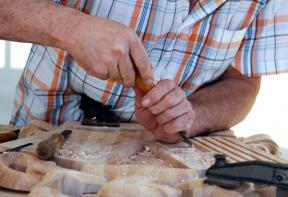Carving letters and numbers to projects
Nothing adds a human touch so beautifully and powerfully as carving
Whenever you build a project in your workshop, you’re launching something into history. The more personal that project is, the more sentimental value it accumulates over the years. This is especially true with gifts, and it’s why I like carving words and dates into my work. Nothing adds a human touch so beautifully and powerfully. And doing a terrific job of adding the details has never been easier, thanks to computers.
A $25 chip-carving knife is the only woodworking tool you need to get started. If you like the results, you might choose to add a skew chisel and a tiny parting tool, but these aren’t really essential.
A chip-carving knife is perfect because it’s designed to slice out long, triangular strips of wood from the face of a board. You make one slice downward at a 45º angle along one side of the letter, and a mirror image slice along the other side of the letter, meeting the first one at the bottom of the cut. With practice, you’ll be able to guide depth of cut and angle correctly so that a nice triangular chip of wood pops out after completing each pair of adjoining knife strokes. You’ll probably find it challenging to get this kind of symmetry at first, but keep at it. Begin by following pairs of straight lines drawn 3/16″ apart on scrap wood. Work at cross-grain and parallel-grain cuts.
Keeping tools razor-sharp is essential. Your knife must be able to slice across all grain directions without tearing the wood. Do yourself a big favour by learning to carve on basswood. When starting out, avoid woods like cedar, white pine and spruce. These woods are a challenge to carve cleanly because of the soft consistency of the grain. Basswood is firmer, and rarely frazzles along cut edges like more common woods.
The most skill-dependent and time- consuming part of the process has always been drawing letters and numbers. You can be an expert carver, but if the lines you’re following are bad, your results will be too. This is where a computer helps. Sidestep the problem of letter layout by printing full-size patterns on paper, then use rubber cement to temporarily fasten the paper to your wood. Simply carve right through the paper, then peel off what’s left of your pattern and sand to remove any glue residue.
Jump to a section
- Page 1 : Adding letters and numbers to projects
- Page 2 : Using computers to speed things up; a detailed drawing
To leave a comment, please log in












No comments